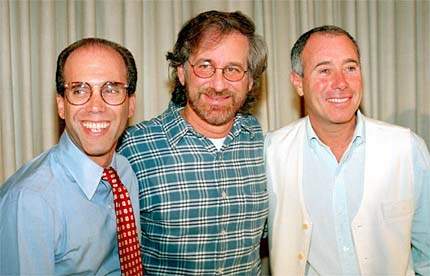It’s back, but just what is it this time?
That’s the essential question, as DreamWorks roars back to life after spending much of 2009 in the credit-market wilderness following its divorce from Paramount.
Now with over $800 million in privately procured financing in the bank and with the launch of six movies into production, the studio begins what can be termed its third life stage — operating as a privately funded company with only one of the original Big 3 founders, Steven Spielberg, still running the show.
 Unshackled from their unhappy Paramount home, and beginning a more simple life as a pure-play movie-production house, DreamWorks officials brim with the kind of hope that can only be found at a studio that hasn’t been around long enough to see anything flop.
Unshackled from their unhappy Paramount home, and beginning a more simple life as a pure-play movie-production house, DreamWorks officials brim with the kind of hope that can only be found at a studio that hasn’t been around long enough to see anything flop.
“Being our own company, we’re now incredibly nimble – we can make quick decisions,” Holly Bario, who co-heads production for the new DreamWorks, told TheWrap.
"It seems to be DreamWorks 3.0," producer Don Murphy told TheWrap from the set of "Real Steel," one of the six movies that have just begun production around the country. "It’s Steven and Stacey (Snider) taking chances on projects they believe in and pushing them out the door."
Of course, everyone seemed pretty happy back in 1994, when the power trio of Spielberg, David Geffen and Jeffrey Katzenberg took $500 million from Paul Allen to create the entertainment company of the future.
It didn’t quite turn out that way, as a new book about the company, "The Men Who Would Be Kings: An Almost Epic Tale of Moguls, Movies, and a Company Called DreamWorks," has described.
Asking if "Dreamworks was a failure," author Nicole LaPorte suggests that despite the talent of the early leaders, "these were not groupthink guys, or team players. They were lone wolves who … locked arms in the face of crisis and catastrophe, but who otherwise tended to their separate fiefdoms."
Has all that changed? While it can’t be called a new studio, this DreamWorks is different from any other DreamWorks that came before it … and this certainly isn’t that DreamWorks.
For one thing, the new DreamWorks is far less ambitious. It’s smaller. And for that reason, it may measure success by a more reasonable scale.
 With Geffen retired, the studio now is short one formidable billionaire founder. Katzenberg has been gone since 2004, having taken the brand to Glendale to oversee DreamWorks Animation.
With Geffen retired, the studio now is short one formidable billionaire founder. Katzenberg has been gone since 2004, having taken the brand to Glendale to oversee DreamWorks Animation.
Also long gone is a music label that once floated such artists as Rufus Wainwright, George Michael and Randy Newman (it was sold to Universal in 2003), as well as a film library that includes everything from “Saving Private Ryan” to “A Beautiful Mind. (Paramount sold off the controlling interest to the library to a group led by George Soros for $900 million shortly after it purchased DreamWorks in 2005.)
Relaunching the company last August with support from Indian media conglomerate Reliance, Spielberg now finds himself partnered with the steady, well-regarded Stacey Snider (pictured with Jennifer Aniston), overseeing a stable, well-regarded staff of about 80 employees who work out of his Amblin Entertainment facility on the Universal lot.
Now distributing through Disney’s Touchstone label, the studio has modest goals to produce about half a dozen movies a year, a few of them tentpoles, the rest of the slate filled out by genre movies.
“We’re looking for a slate that’s well-rounded, and I think we’ve managed to do that in our first year,” said Mark Sourian, a 13-year DreamWorks veteran who, along with Bario – a former Snider charge at Universal – heads up the studio’s production.
Right now, Sourian and Bario are as busy as they’re probably ever going to be, as the studio shifts out of neutral, where it has idled through a year-long credit-crunch-fueled delaying their ability to make movies. Bario says that turned out to be a blessing. The studio “really benefitted from being able to sit back and focus on development,” he said.
D.J. Caruso’s sci-fi thriller “I Am Number Four” is about to wrap production, and Shawn Levy’s futuristic robot-boxing film “Real Steel” (pictured below) starring Huge Jackman, as well as Jon Favreau’s Western/sci-fi hybrid “Cowboys and Aliens” just got started.
Meanwhile, going into production this summer are the adaptation of Kathryn Stockett’s bestseller “The Help,” Spielberg’s boy-and-his-horse epic “War Horse” and Craig Gillespie’s ’80s cult-film remake “Fright Night.”
Then there’s the Jay Roach comedy “Dinner for Schmucks” coming out through Paramount on July 30, a bi-product of the two companies’ tumultuous three-year marriage.
This isn’t that DreamWorks, either.

As DreamWorks was moving out, and dividing up the figurative CD and book collections, valuable assets had to be left behind.
Spielberg will retain a producer credit on “Transformers 3,” for example, but that lucrative franchise now belongs to Paramount.
So does Oren Peli’s follow-up to his low-budget horror phenom “Paranormal Activity,” which was originally championed by Spielberg and former DreamWorks production chief Adam Goodman — who was also left behind at Paramount.
From a franchise standpoint, the new DreamWorks has to start over. But Spielberg was able to acquire 17 projects that were being jointly developed while DreamWorks was ensconced at Paramount — a list that includes such properties as “The 39 Clues,” “Motorcade,” “Atlantis Rising” and “The Trial of the Chicago 7.”
Meanwhile, in moving its distribution pipeline to Touchstone, DreamWorks will be going through a label that hasn’t lit the world on fire of late, last year’s “The Proposal” notwithstanding.
For his part, however, Disney theatrical distribution chief Chuck Viane doesn’t believe there will be any special challenges associated with bringing in DreamWorks fare.
“People forget that along with the family-oriented movies we put out, we’ve also done really well with movies like ‘Armageddon,’" he said.
Of course, Disney is just the distributor, and this DreamWorks – in some ways – might enjoy some of the creative freedom originally envisioned by its “SKG”-monikered founders.
Meanwhile, Reliance has so far been a silent partner in the new company, putting up hundreds of millions in backing without too many strings attached.
“I haven’t heard anybody say, ‘Oh, we have to have a Hindi character in this,’” said a former DreamWorks staffer who still keeps in regular touch with his former co-workers. “(Reliance) seems to be very interested in content, but they seem more interested in finding materials to fill their own pipeline.”
Meanwhile, while its operating in a new set of circumstances, this isn’t really a brand-new DreamWorks that will be prone to making rookie-studio mistakes.
“It would be one thing if DreamWorks 3.0 had to start from scratch,” the former staffer noted. “But they have a lot of people who’ve been around for a little while, and a lot of institutional knowledge. And you’ve got Stacey, who’s a star. They’ve got a really good team there.”
-30-
Lakers!
